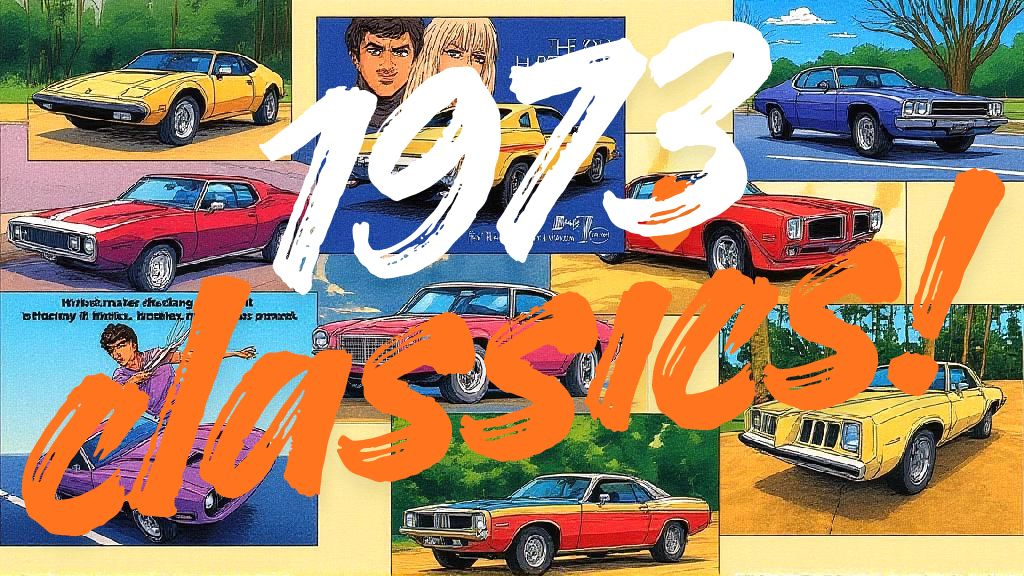1973 was a transitional year for Detroit iron because they were de-tuning cars to make them run on unleaded gas.
The government guys also started the safety bumper mandates in ’73 so two things changed overnight in the world of production cars.
’73 gets branded as the starting gate to the smog/bumper car era but that didn’t mean it was a write-off for style—here are several examples.
Jerry Sutherland
The 1973 Ford Mach 1 was an extension of the 1971-73 ‘Big Horse’ pony cars. Hardcore Mustang guys were lukewarm about this bigger, wider version and many of them thought the legendary pony car had lost its roots as a nimble little car.
Despite that, the 351 Cleveland was still good for a 7-second 0-60 time. The non-fans may have had a point in ‘73, but the big horse Mustangs have a strong following in 2025.
The 1973 Hurst Olds is another great example of ’73 cool.
They had the dual-gate Hurst shifter and a 455 under the hood—the W45 was the best version of a Hurst Olds you could build in 1973. It had enough torque to make it more than a warmed-over 455 Olds, so it could hit 0-60 in 6.5 seconds.
The ’73 Pontiac Trans Am SD 455 was another solid example of how big blocks could still prevail over smog laws.
The SD-455 Trans AM did a 13.75-second, 103 mph quarter mile, so it carried on the T/A tradition of serious performance.
Pontiac also carried on that same Poncho tradition of serious performance with the 1973 Grand Am.
The 455 could haul this big boy to a 0-60 time of around 6.5 seconds. That’s a pretty good number in 2025—and exceptional in 1975. I liked the front end on these cars, because the bullet-like nose treatment was so unique to Pontiac.
The 1973 Cuda was the 3rd year of the E-body configuration for the Mopar pony car. That platform was extremely popular then and now—if current prices tell us anything.
Plymouth coped with the state-mandated bumpers, went back to two headlights, and ended up with a very cool version of the E-body Barracuda. They were down to three engine options, but one of them was the 340. That kept the classic Cuda at respectable performance levels during the firestorm of regulations and OPEC games.
Camaro pumped out a solid version of the Z/28 in ’73.
The Z came with a 245-horsepower, 350 small-block V-8, so it was very competitive in the smog-era world of de-tuned cars. The split-bumper (’70-73) Camaro era is one of my favorites—even though more hardcore Camaro guys line up behind the 1st gen versions.
The 1973 Plymouth Road Runner never achieved the fan base of the 1st Gen ‘runners, but it was an interesting study in early 70s style. I started to warm up to these cars after about 20 years, so now I’m a big fan of the ’73 Road Runner’s coke-bottle curves and power bulges in the hood.
You had several options with the ’73 Runner…right up to a 440 big block with 285 horsepower. They didn’t run like a ’69 with a 440 six-barrel, but the ’73 Road Runners were still a force in their day.
The 1973 Ford Pantera was definitely a performance car—even in ’73.
The 351 Cleveland was mounted mid-engine in the Pantera, and rated at a smog-era 265 horsepower, but it still pushed the car to 60 mph in six seconds. That was Warp 9 in 1973.
The last star smog-era ‘73 car was the AMC AMX. The fender bulges are a matter of debate, but these were truly unique cars.
This car was based on the Javelin platform, and it came with a 401 cubic inch V-8 that pumped out a respectable (for ’73) 255 horsepower. That was a big number for a lighter car in 1973, so the ’73 AMX did a decent 7.7 (0-60) time.
There you have it—1973 in all its glory.
’73 was a year that represented triumph over heavy regulations and OPEC games.
Jerry Sutherland
By: Jerry Sutherland
Jerry Sutherland is a veteran automotive writer with a primary focus on the collector car hobby. His work has been published in many outlets and publications, including the National Post, Calgary Herald, Edmonton Journal, Ottawa Citizen, Montreal Gazette, Saskatoon StarPhoenix, Regina Leader-Post, Vancouver Sun and The Truth About Cars. He is also a regular contributor to Auto Roundup Publications.
- CLICK HERE TO SIGN UP FOR THE NEWSLETTER
- CLICK HERE to Like us on Facebook
- CLICK HERE to Follow us on Twitter
- CLICK HERE to Follow us on Pinterest
